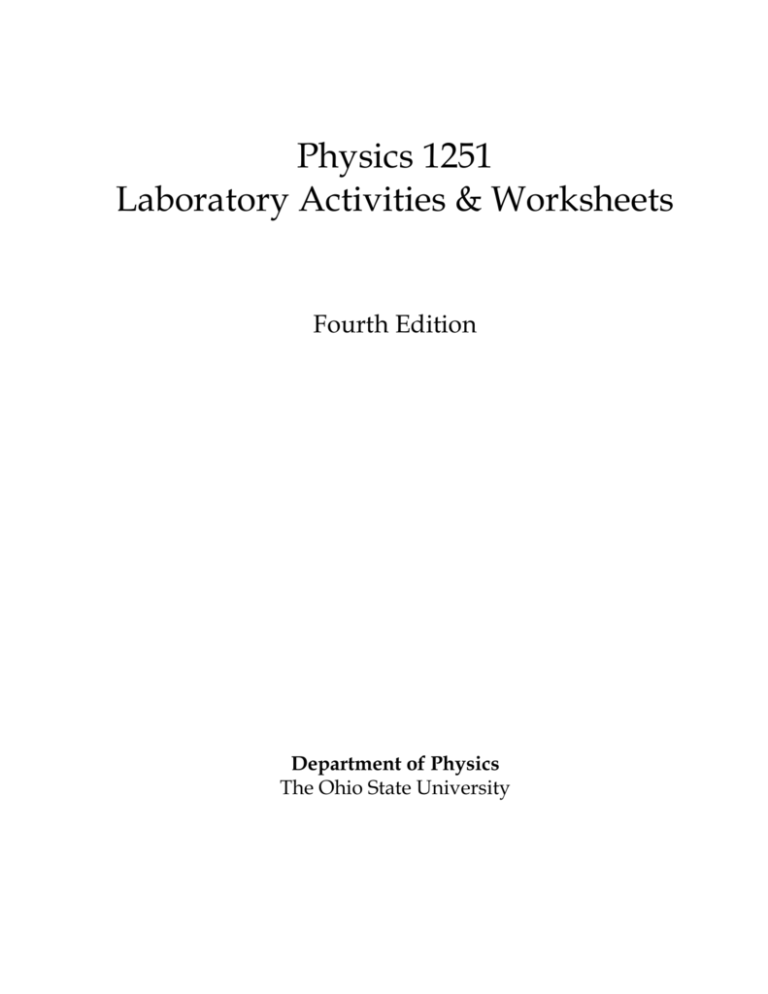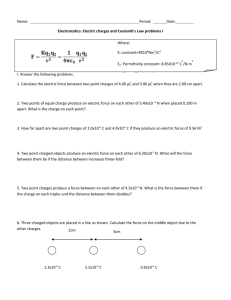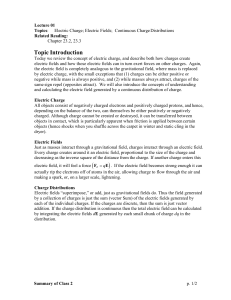
Physics 1251
Laboratory Activities & Worksheets
Fourth Edition
Department of Physics
The Ohio State University
Copyright 2015 by the Department of Physics, The Ohio State University
All rights reserved.
Permission in writing must be obtained from the publisher before any part of this
work may be reproduced or transmitted in any form or by any means, electronic or
mechanical, including photocopying and recording, or by any information storage
or retrieval system.
Printed in the United States of America
10 9 8 7 6 5 4 3 2 1
ISBN 978-0-7380-7643-09
Hayden-McNeil Publishing
14903 Pilot Drive
Plymouth, MI 48170
www.hmpublishing.com
TABLE OF CONTENTS
Lab Instructions
Experiment I –
Experiment II –
Experiment III –
Experiment IV –
Experiment V –
Experiment VI –
Experiment VII –
Experiment VIII –
Experiment IX –
Experiment X –
Experiment XI –
Experiment XII –
Experiment XIII –
Experiment XIV –
Experiment XV –
Experiment XVI –
Worksheets
Electric Force
Electric Field
Electric Flux
Electric Potential
Electric Current
Qualitative Circuits
Quantitative Circuits
Magnetic Torque
Magnetic Fields
Magnetic Induction
Inductor Circuits
Standing Waves
Wave Superposition
Microwave Interference
Light Interference
Spectroscopy
i
Lab Instructions
The two-hour lab session lies at the heart of this course. In it a combination of
problems and laboratory activities is worked in small groups with the assistance of
the instructor. These sessions are where you can best learn the material, in order to
be able to complete the homework assignments and be prepared for the quizzes and
exams that will determine your grade. The following are answers to questions you
might have.
Typically, you and your group will be given a combination of problems and
laboratory activities to do in a set order. The problems and some of the laboratory
activities are not graded, but some of the laboratory activities may be graded. The
graded activities, indicated clearly in this manual, together constitute the “lab
score.” Your lecturer will explain how the lab score combines with other course
elements to determine your grade.
Your group is not expected to finish every problem! We would rather that you work
a few problems well with complete understanding than a large number using guesswork.
You should record all measurements and calculations in your individual lab
manual. (The other members in your group are expected to do the same.) Your
instructor may ask to examine it at any time. You are encouraged to ask for help
from your instructor at any time. You are welcome to use your textbook and class
notes. Also, do not forget that you are part of a group. Bring this manual and a
scientific calculator to class.
Be on time. If you come late, you may not be allowed to perform the lab.
Academic Misconduct: (These considerations are in addition to the general
University rules.) All laboratory work will be done during the laboratory period. Do
not bring completed lab work to the laboratory. The presence of completed material
in the lab book can be considered evidence of intent to commit academic
misconduct. Do “graded activities” only when your instructor is watching. Do not
mistreat the laboratory equipment -- in particular, do not write on the apparatus. If
you are uncertain what is permitted while doing a given graded lab activity, ask
your instructor before proceeding.
ii
Experiment I – Electric Force
Twenty-five hundred years ago, the Greek philosopher Thales found that amber, the
hardened sap from a tree, attracted light objects when rubbed. Only twenty-four
hundred years later, in the latter part of the nineteenth century, systematic
investigations led to the formulation of a conceptual model of electricity that explains
Thales’ experiments. In this lab, we will develop our own conceptual model for
electricity by analyzing a series of simple experiments. Although you have already
learned a number of basic concepts in lecture, these rules, such as the one stating that
objects with opposite electric charges attract one another, were stated without proof. In
this lab, you will conduct a series of simple experiments to convince yourself that your
observations are consistent with these empirical rules. When performing the activities,
be careful to avoid assumptions that might not be consistent with your observations.
Construct explanations and conclusions from your observations alone.
Activity 1
Remove two 10-cm long pieces of regular
clear tape from a roll of tape. Curl the ends
of the tape over to make handles (see the
sketch at the right). Press the sticky sides of
the tape to the top of the lab table and rub
them so that they make good contact with
the table. Then, quickly pull the strips of
tape off the surface and bring the non-sticky
sides of the tape near each other.
Handle
Sticky side of tape
What happens? Does it matter which sides
of the strips face each other? How does the
distance between the strips affect what
happens?
Electric Force
I-1
Activity 2
Stick a new 10-cm strip of Scotch tape with a handle to the lab table. Label
the handle of this strip with a “b” for bottom strip. Place a second new
strip on top of the first strip. Label the handle of this strip with a “t” for
the top strip. Rub the strips so they make good contact with the table and
with each other. Quickly pull the bottom (“b”) strip (with the t-strip still
attached to it) off the table and then pull the two strips apart and bring
their non-sticky sides near each other.
What happens? Does it matter which sides of the strips face each other?
How does the distance between the strips affect what happens?
Activity 3
Attach the two pieces of tape from the previous experiment to the wood
dowel so that the strips hang down from the dowel. Repeat Activity 2, to
create a second b-strip and a second t-strip. Hold each of the new strips
first near the original b-strip and next near the original t-strip.
If two similar objects are prepared in the same way (i.e. tapes that are
pulled off a lab bench), it is reasonable to believe that the two objects have
the same type of charge. What can you say about the force between two
objects of the same type? About two objects of different type?
We will give the name “charge” to the properties you have just observed. We will find
later that objects with no electric charge can exert attractive forces on both the b-tape
and the t-tape. Your body is such an object. When performing the following
experiments, hold the rubbed objects away from your body so that you do not measure
a force of your body on the hanging tapes. Also, in humid conditions, the electric
charge on the pieces of tape can “leak off” causing them to become discharged. You
may have to repeat Activity 2 from time to time to recharge your t- and b-strips.
Electric Force
I-2
Activity 4
Rub a soft white cloth vigorously against a blue Styrofoam insulation
board. Hold the board near the t-strip and then near the b-strip. Does the
blue board have the same electric charge as the t-strip or as the b-strip.
Why?
Activity 5
You have other objects at your lab table. Try rubbing some of these
objects together (for example, a glass rod with silk or a plastic tube with
wool) to determine whether they have “t-type” electric charge or “b-type”
electric charge after rubbing. List only those objects or types of material
that are clearly t-type or b-type. Try to find two objects of each type.
t-type material
b-type material
Did any charged objects attract both t-strips and b-strips? Be sure to
consider only objects that were charged sufficiently and that had a clear
attraction to both. What does this imply (but not prove) about the number
of different types of electrical charge?
Electric Force
I-3
You have charged objects electrically, by pulling tape off a lab table or by rubbing an
object. You have observed two charged objects exert forces on each other. The electric
force is similar to the force of gravity in that it is a non-contact force; the objects do not
have to be in physical contact in order to exert a force on each other. Being charged
electrically is a property that an object may or may not have. The presence of this
property is inferred from observations of forces that objects exert on other objects in
experiments like those you have made in this lab.
For now, we will arbitrarily state that the b-tape pulled off the lab bench has a negative
electric charge (-) and the t-tape pulled off the back of the tape has the opposite positive
charge (+). This labeling by (+) and (-) dates back to Benjamin Franklin. Keep in mind,
we could have chosen other names for the charge; these signs are just words to help us
describe a property of matter that produces electric force.
Activity 6
Be sure that you have charged b-type (- charge) and t-type (+ charge)
tapes hanging from the wooden dowels. Hold an empty aluminum pop
can first near the t-tape and then near the b-tape. This experiment
requires careful observation.
Question
Does the can seem to have + electric charge, - electric charge, no charge, or
is some other explanation needed?
Activity 7
Cut or tear a piece of paper into many small bits and lay them on the lab
bench. Very vigorously rub the Styrofoam board with a soft cloth or a
wool cloth. Then, bring the charged foam board near the paper but do not
touch the board to the paper. What happens?
Electric Force
I-4
Using the table of the previous page, select an object that has an opposite
charge to that of the foam board. Try the same experiment with this new
object. What happens when this oppositely-charged object is brought near
the paper?
Based on the outcome, decide if the paper seems to have electric charge and if so,
the sign of the charge. Or, is some other explanation needed for your
observations?
Here we have seen an example of a charged object attracting a neutral object.
The attraction occurs whether the charge object is positively charged or
negatively charged. The model that explains this describes a neutral object as a
body containing a very large number of charged particles, called protons and
electrons. In a conductor, some of the electrons can move around. In an insulator,
electrons cannot move, but they may “shift” so that their average position is not
the same as the average position of the nucleus. We call this polarization.
To model what you have observed, draw the distribution of charges “induced”
in opposite sides of the conducting can by the charged rod.
+
+
+
+
Electric Force
I-5
Draw the distribution of charges “induced” within the insulating paper by
the charged rod.
+
+
+
+
Activity 8
Connect both aluminum cans to the same side (either side) of the
Wimhurst machine (get your lab instructor’s help). Arrange the cans so
that they are very close to but not touching each other. As you crank on
the Wimhurst machine, the cans will repel each other. What does this say
about the charges on the two cans? What would happen if we attached
the cans to opposite sides of the machine? Note: as you do the
experiment, you want the cans to be close to but not touching each other.
Estimate the amount of charge on each can (assume that they have the
same charge). Be sure you start with a free body diagram.
Instructor Initials: ___________________
Electric Force
Date: __________
I-6
Coulomb’s Law
(1)
q1
The figure shows three point charges positioned in an
equilateral triangle. q1 = q2 = 20.0 mC, q3 = 30.0 mC and d = 1.50
m.
d
q3
d
What is the force on q3? (A harder problem would be to find the
force on q1. If you can work that, you know what you need to
know about vectors at this point in the class.)
d
q2
-3q
(2)
A number of charges are placed as shown in the
figure, where q = 1.2 nC and the circle radius is 2.3
cm. What is the electrostatic force on the charge in
the center?
[Notation: 2q simply means a charge that is twice q
where q can be any value and any sign. +2q means
that the charge is definitely positive.]
+2q
+q
+q
+10q
+2q
-3q
(3)
Two charges, q1 and q2, are fixed in place some distance apart. Both charges are
negative, but the magnitude of charge q2 is larger than the magnitude of q1.
Sketch a picture of the situation. Indicate on your sketch those places, if any,
where a positive charge q3 could be placed and experience zero electrostatic
force. How does your answer change if q3 is negative?
y
(4)
Point charges are positioned as shown in the
figure. What is the net force, F, on the –Q charge
due to the other charges? Try to not perform
calculations that aren’t necessary.
d
-2q
-2q
-Q
-q
Worksheets
x
d
-d
-d
+2q
1








